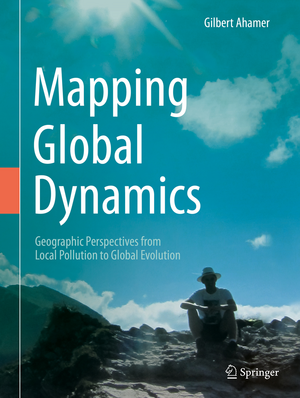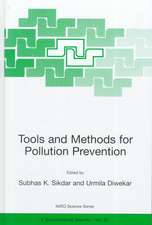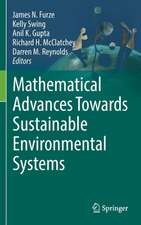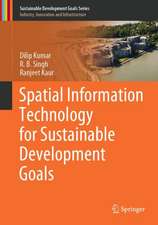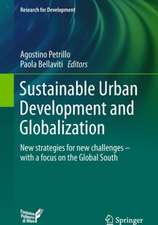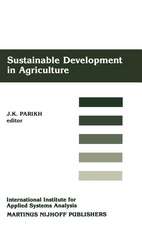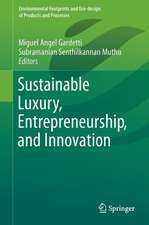Mapping Global Dynamics: Geographic Perspectives from Local Pollution to Global Evolution
Autor Gilbert Ahameren Limba Engleză Hardback – 20 oct 2020
It adopts a spatial perspective when trying to understand “Global Dynamics” – and sets out to revolutionise the concept of space as such. Spatial views – on levels of increasing abstraction, reflection and self-organisation – are developed along eight case studies including air emissions, environmental radioactivity, deforestation, energy from biomass, land use change, food supply, water quality and cooperative interdisciplinary learning for global change.
This book’s conceptual innovation consists in performing a transformation from “space & time” into “functional state space & evolutionary time” in order to better recognise the structural patterns of long-term global dynamics.
A transdisciplinary readership in academia – including geography, philosophy, economics, global change and future research – that is interested in enlarging scientific concepts beyond classical borders – would be most welcome!
Preț: 1419.71 lei
Preț vechi: 1731.35 lei
-18% Nou
Puncte Express: 2130
Preț estimativ în valută:
271.65€ • 284.40$ • 224.78£
271.65€ • 284.40$ • 224.78£
Carte disponibilă
Livrare economică 17-31 martie
Preluare comenzi: 021 569.72.76
Specificații
ISBN-13: 9783319517025
ISBN-10: 3319517023
Pagini: 636
Ilustrații: XLII, 436 p. 570 illus., 169 illus. in color.
Dimensiuni: 210 x 279 mm
Greutate: 1.55 kg
Ediția:1st ed. 2019
Editura: Springer International Publishing
Colecția Springer
Locul publicării:Cham, Switzerland
ISBN-10: 3319517023
Pagini: 636
Ilustrații: XLII, 436 p. 570 illus., 169 illus. in color.
Dimensiuni: 210 x 279 mm
Greutate: 1.55 kg
Ediția:1st ed. 2019
Editura: Springer International Publishing
Colecția Springer
Locul publicării:Cham, Switzerland
Cuprins
Chapter1. Objectives leading to a vision.- Chapter2. Mapping in eight case studies.- Chapter3. Lessons learned while mapping.- Chapter4. Conclusions for global dynamics.- Chapter5. Additional material from practice.
Textul de pe ultima copertă
This book asks: What are the most suitable “mapping strategies” for detecting patterns of global dynamics?
It adopts a spatial perspective when trying to understand “Global Dynamics” – and sets out to revolutionise the concept of space as such. Spatial views – on levels of increasing abstraction, reflection and self-organisation – are developed along eight case studies including air emissions, environmental radioactivity, deforestation, energy from biomass, land use change, food supply, water quality and cooperative interdisciplinary learning for global change.
This book’s conceptual innovation consists in performing a transformation from “space & time” into “functional state space & evolutionary time” in order to better recognise the structural patterns of long-term global dynamics.
A transdisciplinary readership in academia – including geography, philosophy, economics, global change and future research – that is interested in enlarging scientific concepts beyond classical borders – would be most welcome!
It adopts a spatial perspective when trying to understand “Global Dynamics” – and sets out to revolutionise the concept of space as such. Spatial views – on levels of increasing abstraction, reflection and self-organisation – are developed along eight case studies including air emissions, environmental radioactivity, deforestation, energy from biomass, land use change, food supply, water quality and cooperative interdisciplinary learning for global change.
This book’s conceptual innovation consists in performing a transformation from “space & time” into “functional state space & evolutionary time” in order to better recognise the structural patterns of long-term global dynamics.
A transdisciplinary readership in academia – including geography, philosophy, economics, global change and future research – that is interested in enlarging scientific concepts beyond classical borders – would be most welcome!
Caracteristici
Mapping Global Dynamics
Follows a truly transdisciplinary approach.
Starts out with quantitative science and reaches metatheory.
Adds dynamic patterns to the concept of global change.
Combines approaches from technology, environment, globalisation and ontology - all from one author.
Draws philosophical conclusions from global modelling results.
Revolutionises the concept of space.
Follows a truly transdisciplinary approach.
Starts out with quantitative science and reaches metatheory.
Adds dynamic patterns to the concept of global change.
Combines approaches from technology, environment, globalisation and ontology - all from one author.
Draws philosophical conclusions from global modelling results.
Revolutionises the concept of space.
